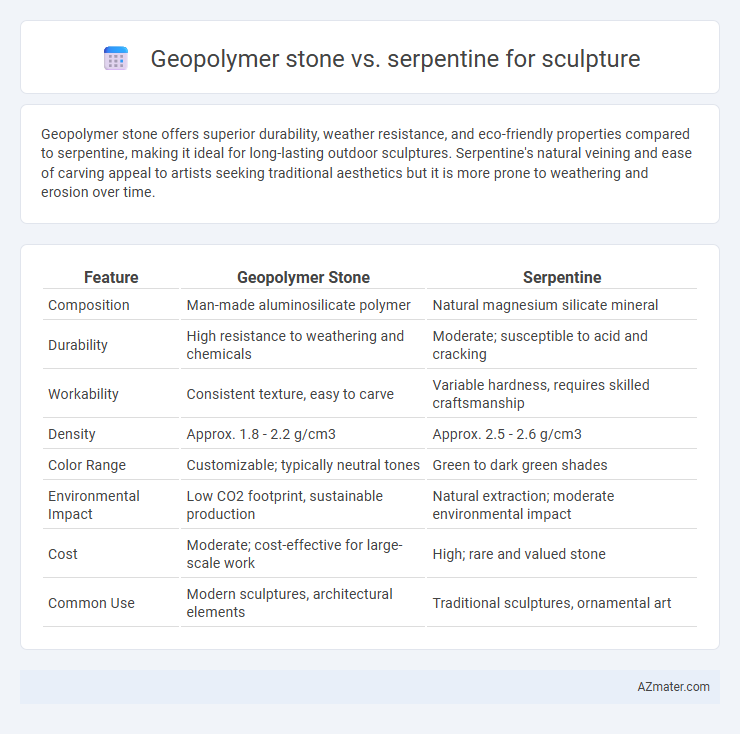Geopolymer stone offers superior durability, weather resistance, and eco-friendly properties compared to serpentine, making it ideal for long-lasting outdoor sculptures. Serpentine's natural veining and ease of carving appeal to artists seeking traditional aesthetics but it is more prone to weathering and erosion over time.
Table of Comparison
| Feature | Geopolymer Stone | Serpentine |
|---|---|---|
| Composition | Man-made aluminosilicate polymer | Natural magnesium silicate mineral |
| Durability | High resistance to weathering and chemicals | Moderate; susceptible to acid and cracking |
| Workability | Consistent texture, easy to carve | Variable hardness, requires skilled craftsmanship |
| Density | Approx. 1.8 - 2.2 g/cm3 | Approx. 2.5 - 2.6 g/cm3 |
| Color Range | Customizable; typically neutral tones | Green to dark green shades |
| Environmental Impact | Low CO2 footprint, sustainable production | Natural extraction; moderate environmental impact |
| Cost | Moderate; cost-effective for large-scale work | High; rare and valued stone |
| Common Use | Modern sculptures, architectural elements | Traditional sculptures, ornamental art |
Introduction to Geopolymer Stone and Serpentine
Geopolymer stone is an innovative material composed of aluminosilicate-rich industrial byproducts like fly ash or metakaolin, offering high durability, resistance to weathering, and eco-friendly properties ideal for sculpture. Serpentine, a natural metamorphic rock known for its smooth texture and distinct greenish hues, has been traditionally favored by sculptors for its workability and aesthetic appeal. Comparing the two, geopolymer stone provides enhanced structural strength and sustainability, while serpentine delivers unique natural patterns and a classic sculptural medium.
Historical Use in Sculpture
Geopolymer stone, a modern synthetic material developed from aluminosilicate powders, offers enhanced durability and environmental benefits compared to traditional stone sculpting materials. Serpentine, historically significant and widely favored since ancient times, has been prized for its smooth texture and vibrant green hues in classical and Renaissance sculptures, especially in regions like Italy and New Zealand. While serpentine carries centuries of artistic heritage, geopolymer stone enables contemporary sculptors to achieve intricate details and sustainable practices without compromising on strength or aesthetic versatility.
Composition and Material Properties
Geopolymer stone consists of aluminosilicate materials activated by alkaline solutions, resulting in high compressive strength, chemical resistance, and environmental sustainability, making it durable and suitable for intricate sculpture work. Serpentine is a naturally occurring mineral primarily composed of magnesium silicate with a characteristic softness and flexibility that allows detailed carving but is more prone to weathering and chemical alteration. The inorganic polymerization in geopolymer stone provides superior dimensional stability and resistance to acid attack compared to the hydrous magnesium silicate structure of serpentine, which influences the longevity and maintenance of sculptures.
Aesthetic Qualities and Appearance
Geopolymer stone offers a smooth, consistent texture with customizable pigmentation that mimics natural stone, providing a versatile palette for intricate sculptures. Serpentine is prized for its rich green hues and swirling patterns, creating a visually striking, organic appearance with subtle veining and a natural luster. The choice between the two depends on desired visual effects; geopolymer stone excels in uniformity and color control, while serpentine delivers unique, natural beauty with varied tonal depth.
Workability for Artists
Geopolymer stone offers superior workability for artists due to its lightweight nature and ease of carving, allowing for intricate details and faster shaping compared to traditional stones. Serpentine, while appreciated for its smooth texture and natural polish, tends to be denser and less forgiving, requiring more effort and specialized tools during sculpting. The customizable curing process of geopolymer stone also provides artists with better control over hardness and texture, enhancing creative flexibility.
Durability and Longevity
Geopolymer stone exhibits superior durability and weather resistance compared to serpentine due to its engineered composition, which enhances its ability to withstand erosion, chemical exposure, and temperature fluctuations. Serpentine, a natural metamorphic rock, is softer and more susceptible to weathering and acid rain, potentially reducing its longevity in outdoor sculptures. Sculptors prioritizing long-term preservation favor geopolymer stone for its consistent structural integrity and minimal maintenance requirements over time.
Environmental Impact Comparison
Geopolymer stone offers a significantly lower environmental impact compared to serpentine, as it is manufactured using industrial byproducts like fly ash and slag, reducing the demand for natural stone extraction and lowering carbon emissions. Serpentine quarrying leads to habitat destruction and generates more greenhouse gases due to intensive mining processes and transportation. The use of geopolymer stone supports sustainability by promoting recycling and minimizing ecological footprints in sculpture production.
Cost and Availability
Geopolymer stone is cost-effective and widely available due to synthetic production methods that utilize industrial byproducts, making it a budget-friendly option for sculptors. Serpentine, a natural stone, often comes at a higher price and may have limited availability depending on quarry locations and quality. Sculptors seeking affordability and consistent supply tend to prefer geopolymer stone over serpentine for their projects.
Suitability for Indoor and Outdoor Sculptures
Geopolymer stone offers exceptional durability and weather resistance, making it highly suitable for both indoor and outdoor sculptures exposed to varying climates. Serpentine, prized for its smooth texture and vibrant green hues, is ideal for indoor sculptures due to its susceptibility to weathering and chemical erosion in outdoor environments. Sculptors seeking longevity in exterior installations often prefer geopolymer stone for its stability, while serpentine remains favored for detailed indoor art pieces requiring fine carving and polish.
Choosing the Best Material for Sculptural Projects
Geopolymer stone offers superior durability, weather resistance, and versatility compared to serpentine, making it ideal for outdoor and large-scale sculptures. Serpentine, prized for its natural veining and ease of carving, suits detailed indoor sculptures requiring a classic aesthetic. Selecting the best material depends on the project's environmental exposure, desired texture, and longevity requirements.

Infographic: Geopolymer stone vs Serpentine for Sculpture
 azmater.com
azmater.com